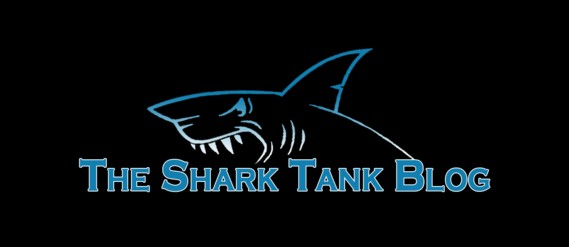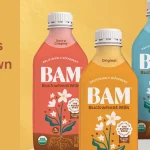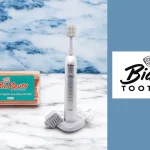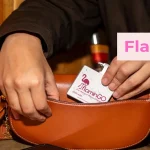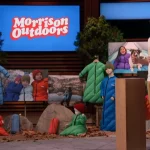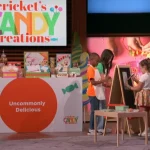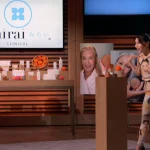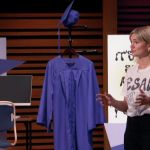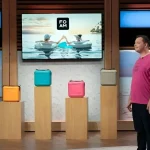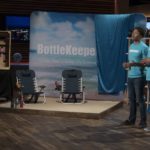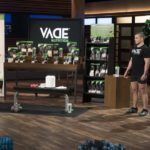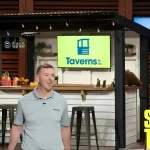Beyond the Tank Episode 205
 Beyond the Tank episode 205 aired Tuesday, March 29, 2016. Four Shark Tank companies get an in-depth, 15 minute update segment on what their life is like after Shark Tank and viewers get to see them interacting with their investor/sharks. Beyond the Tank episode 205 begins with Pat Yates and Happy Feet; he did a deal with Robert in season five and saw his business skyrocket. Curt Campbell left the Tank without a deal in season six, but his olive oil franchising concept, The Oilerie, continued its steady growth. Barbara invested in the Scratch and Grain Baking Company in season six and helped guide the business through problems with machinery and with cash for funding purchase orders. Way back in season 1, Daymond invested in Treasure Chest Pets. The business closed in 2012, but she’s still working with Daymond!
Beyond the Tank episode 205 aired Tuesday, March 29, 2016. Four Shark Tank companies get an in-depth, 15 minute update segment on what their life is like after Shark Tank and viewers get to see them interacting with their investor/sharks. Beyond the Tank episode 205 begins with Pat Yates and Happy Feet; he did a deal with Robert in season five and saw his business skyrocket. Curt Campbell left the Tank without a deal in season six, but his olive oil franchising concept, The Oilerie, continued its steady growth. Barbara invested in the Scratch and Grain Baking Company in season six and helped guide the business through problems with machinery and with cash for funding purchase orders. Way back in season 1, Daymond invested in Treasure Chest Pets. The business closed in 2012, but she’s still working with Daymond!
Find out more on this episode of on Beyond the Tank.
Beyond the Tank Episode 205 Featured Sharks
- Investor – Daymond John
- Investor – Barbara Corcoran
- Investor – Robert Herjavec
Beyond the Tank Episode 205 Entrepreneurs
- Company – Happy Feet
- Company – The Oilerie
- Company – Scratch & Grain Baking Company
- Company – Treasure Chest Pets
Beyond the Tank Episode 205 Recap
Happy Feet
Pat Yates came to the Shark Tank in season 5 with his line of plush slippers, Happy Feet. His sales coming into the Tank were $2.65 million, but he had been unable to get into retail outlets because of the size of the product.
Kevin and Lori made an offer of $375,000 in return for 30%. Robert Herjavec makes the same offer. Pat told them he’d accept an offer for 25%. Robert quickly accepts and does a deal with Happy Feet.
“Robert was definitely the top in who I wanted a deal with,” recalls Pat. “I just felt he was going to be the best for my business overall.”
In the year since Happy Feet appeared on Shark Tank, sales have soared to $4.2 million, with $135,000 on the night of the airing alone. When the episode aired, Dreamworks Animation reached out to Happy Feet and offered a licensing deal, which would provide Happy Feet with an opportunity to create retail spaces through kiosks.
“The key word with licensing is ‘process,’” says Robert. “It takes a long time. First you have to go through the agreement, and then you have to structure the deal. Once you negotiate the paperwork and the contracts, then you’ve got to actually make the product.”
The actual design of the product is important for an animation company. Dreamworks won’t approve slippers that don’t closely match their animation style and the looks of their characters. Pat and Robert are meeting to discuss the upcoming licensing deal and the future of Happy Feet.
Growth has been 50% for the first year, but the Dreamworks deal could take the sales to $8 to $10 million. They discuss price points. The basic Happy Feet slippers cost around $24.99, but the Dreamworks slippers will cost as much as $35. Robert encourages Pat to raise his price point to $37, reminding him that he can always lower the price later, but that raising a price will create consumer resentment.
The Dreamworks deal is a critical point in the future of Happy Feet. “Every company,” says Robert, “Has one of those moments in their existence, where if this happens, it could double the size of the company. This is that moment. We’ve doubled already, and this deal alone will double us again.”
Robert accompanies Pat to a meeting with Dreamworks executives. Pat presents his vision for the kiosk design to the group. Robert’s support moves the meeting forward. Dreamworks is looking for a low-cost entry into retail markets, and the kiosks represent an excellent opportunity for them as well as Pat. The execs are impressed with Pat’s hard work to pick up the detail of their characters.
“We’ve worked with you a long time on this. You’ve brought out all the character on our character. This is better than good enough. It’s exceptional. It’s approved. Go. Make money.” Dreamworks signs the deal, and Pat gets the licensing.
“Closing the deal is really the holy grail,” says Robert.
With Robert’s support, Happy Feet is on its way to leaving footprints all over America.
The Oilerie
Curt came to Shark Tank during season 6, looking for help expanding a franchise system. He came in with sales of $3.7 million through seven franchises. The Sharks weren’t certain that Curt could handle the pressure of running a franchise model business.
“Coming out of the Shark Tank without a deal,” remembers Curt, “Was devastating.”
They didn’t think he could handle the stress. Curt took their advice to heart, but his wife Amy Jo supported him through the two months it took him to bounce back.
“It’s not just bootstrapping your company,” says Curt. “It’s bootstrapping yourself.”
He sought out help, hiring corporate trainers to help train the franchisees and expand his business.
“Being on Shark Tank was an absolute blessing, but it also challenged my confidence in myself when I didn’t get the deal. Could I really do this? Could I really pull it off? In the end I decided, absolutely I could pull it off.”
The Oilerie is succeeding, in spite of the Sharks’ rejection.
Treasure Chest Pets
Lisa came to the Shark Tank in season one. She’d done over $30 million in sales with products she’d invented and licensed, but Treasure Chest Pets was the first product she manufactured and sold herself.
Daymond John made an offer to handle all the manufacturing, but asked for 60% of the company. Lisa accepted the deal.
“I invested in Treasure Chest Pets for two reasons,” remembered Daymond. “One, the product was adorable. But also, Lisa. She already had a history with consumer products, and I figured, great entrepreneur, great product: home run.”
With Daymond’s support, Lisa got Treasure Chest Pets into Buy Buy Baby, and sales exploded. Soon, however, the economy tanked, and sales dropped off. Fuel prices went up and costs kept rising. Treasure Chest Pets was in trouble.
“The mistakes that I’d made, plus the recession left me in dire straits,” remembers Lisa.
She went to Daymond John for help, but he told her “do not throw good money after bad money.”
In 2012, Lisa closed down Treasure Chest Pets.
“It’s not as easy as it looks,” said Daymond. “We’ve learned a lot from experiences like this.”
After the loss of Treasure Chest Pets, Lisa moved to New Orleans, and got involved in the local entrepreneur community, working one-on-one with startups and entrepreneurs to license their products.
She’s also created a new line of temporary tattoo masks, Masque Rage.
“Lisa’s had her good times, she’s had her bad times,” says Daymond, “but you know what, she knows that failure is the fuel to her success. It’s in Lisa’s blood, she’s an inventor, she’s an entrepreneur, she will not stop, and that’s why I’ve decided to partner up with Lisa and bring her into my company to teach my new Shark Tank guys and girls how to operate the businesses. She’s one of those key components that I needed in Season One to help me with my investments and I love working with Lisa.”
“I don’t see failure as a terrible thing anymore,” says Lisa. “It teaches me more than all the success I ever had. I don’t think I could’ve ever dreamed that life could turn out this good.”
Scratch & Grain Baking Company
Leah and Taya came to Shark Tank in season six with Scratch & Grain. They had accomplished $52,000 in sales. They needed help automating their processes.
Robert offered $150,000 for 40%, if the pair could convince Barbara Corcoran to come in on the deal. Barbara had ideas of her own. She made her own offer, leaving Robert out.
“Taya and Leah are great partners. They have tremendous energy,” says Barbara, “They work well together, and they have a great product that makes baking easy.”
As the ladies hoped, working with Barbara, they have been able to automate parts of the process of packaging their product. Unfortunately, the machinery has begun breaking down.
The entrepreneurs thought that buying machines from overseas suppliers, saving almost 80% of the cost of buying machines made in the USA, was a good idea, until the problems with a lack of instruction manuals and English labels started piling up.
Target has made an offer to put two of the Scratch & Grain products into 1,500 locations. Production is just one problem. Cash flow is the other problem. The Target order will cost $100,000 to fund, but could bring a $400,000 to $500,000 profit. It’s time for the partners to talk to their Shark.
The girls bring Barbara their new boxes. Thankfully the design is not finalized. Barbara feels the crafty looking packaging is important to the brand.
The girls were able to get the machines working, but the machine issues are causing variable costs in the operation, causing down time during production.
“When you multiply your need to produce product by a hundred, you can’t afford to have downtime,” warns Barbara. “You’re standing so tentatively on a little piece of the cliff, ready to just fall off and your whole business go down with it.”
Barbara tells them that their number one priority is to find a repair person to handle the machine breakdowns. She gives them two weeks to do that.
They then present Barbara with their cash flow problem. Barbara tells the pair that she could give them the $100,000, but to do that would be “to do them a disservice.” She feels they need to learn to stand on their own two feet. She advises them that they need a local bank to give them a line of credit.
Barbara gives the pair their marching orders. They need to get a repair person for their machines, and visit the local bank to arrange the credit line.
“I haven’t changed my impression of Leah and Taya since the day I met them on Shark Tank,” says Barbara. “They are great entrepreneurs, but I’m counting on their natural talents to pull them through and hit that finish line, and I bet I’m right.”
“Leah and I are going to make this company work,” says Taya. “We’re going to get our paychecks, and we’re going to make this a successful business.”

